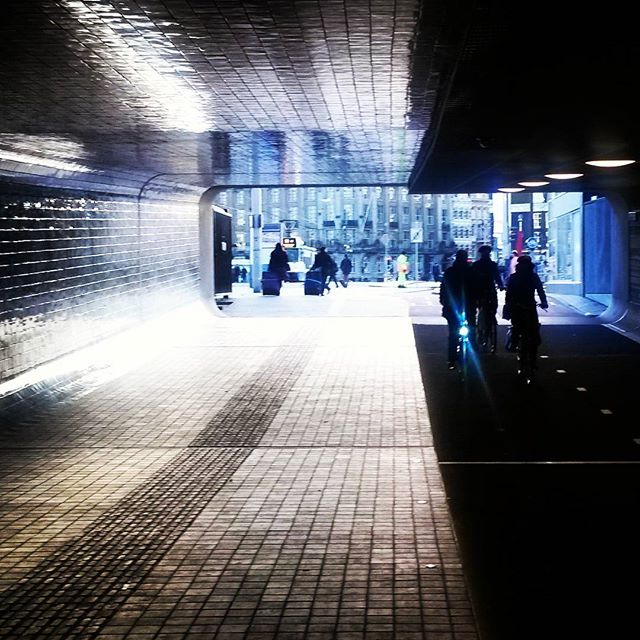
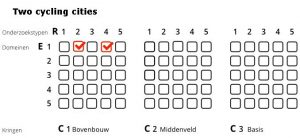
Projectnaam / Project name
Making cycling attractive, safe and convenient in cities: Lessons to learn from Amsterdam and Milan
Short name: two cycling cities
Projecteigenaar, of -opdrachtgeve/ Project owner, or client
Ghent University
Projectomgeving / Project setting
Ghent University (Faculty of Engineering and Architecture), Favas.net (www.favas.net).
Projectonderzoeker of -uitvoerder / Project researcher or actor
Muhammad Wisal Khattak
Trekker Fietscommunity / Lead partner Fietscommunity
Rob van der Bijl
Tweede contact/ Second contact
Ghent University
Trigger / Trigger
Cycling has both personal and collective benefits. Policymakers are interested to increase the share of cycling and walking for a wider range of trips. Some cities successfully incorporate cycling as a mode of transport while others do not. What makes the difference?
Domeinen / Domains
(E1) Effectieve mobiliteit / Effective mobility
Kringen / Circles
(C1) Bovenbouw / Superstructure:
Onderzoekstype / Types of research
(R2) Toegepast wetenschappelijk / Applied scientific
(R4) Toegepast beleidsmatig / Applied policy
Samenvatting / Summary
Cycling has been established as a main mode of transport in urban areas. Because of increasing concerns about the environment, road safety, congestion, and sustainability, cities are constantly seeking to adjust their existing transport systems in favor of sustainable modes. Using various resources, the author examined cycling situations in Amsterdam and Milan. This report presents a detailed overview of cycling policy, infrastructural measures, promotions, education, modal shares and other innovative interventions in these cities.
It was found that a concrete bicycle strategy in urban mobility plan, that ensures implementation of multi-faceted, mutually reinforcing policies, focused on more pro-bike measures while at the same time restraining automobiles from entering city center, is vital for the success of cycling. Lack of common vision between the demand side (users) and the supply side (government) and the absence of adequate cycling infrastructure contribute towards the failure of cycling. A clever combination of hard and soft policies for promoting cycling is indispensable. Communicating cycling, raising awareness, offering incentives and making people accustomed to cycling on the roads is as important as safe, complete, comfortable, attractive and high-quality infrastructure in urban bicycle policies.
Without a second opinion, Amsterdam’s cycling that shows bicycle as equally capable mode transport for everyday short trips is exemplary for Milan and other cities. Following a Dutch example, states, regions, and cities can obtain the highest possible level of cycling.
Uw tags / Your tags
Mobility planning, Space and mobility, Cycling assessment, State of the art cycling
Beschrijving / Description
Doel en opzet / Aim and plan
Policymakers are interested to increase the share of cycling and walking for a wider range of trips. However, only a few cities, for instance, Amsterdam (and Copenhagen), have managed cycling very well, while others, to say Milan (and Stockholm), although good examples of modern cities have not (Nielsen et al., 2013 and Emanuel et al., 2012). It is not uncommon to see that, although policies exist, some cities have succeeded in having higher levels of cyclist shares in everyday trips than the others. To understand this, it is important to have a closer look at the cities with a successful cycling culture and those with relatively less success in cycling. This research entails a case of Amsterdam in the successful category and Milan of the city with a relatively compromised success in cycling as so far.
Organisatie en financiering / Organization and funding
Ghent University in context of the course ‘Mobility and Space’ (2018-2019).
Periode en beschikbaarstelling / Period and availability:
Report delivered Januari 2019.
Werkpakketten/ Work packages
Is the distance to cover by bicycle affect the number of cyclists in cities?
Does the development form of cities affect the choice of a bicycle for transport?
What is the popular mode of transport in both urban contexts?
Are different means of transports integrated and connected well in two cities and do they also allow the bikes use for long distances?
What are the main travel motivations that influence travel behavior and the bikes mode choice?
In both bikes’ plans which infrastructural strategy effectively helps to increase the actual number of urban cyclists?
What can be learned from the case studies of Amsterdam and Milan?
Toepassingen/ Applications
Enhanced policy making.
Overige / Other
Cycling has multiple advantages, related not only to transportation, but also health, environment, and spatial planning. Integration of cycling into overall transport policy, and in other policy domains like health, environment and urban planning can be instrumental in increasing the actual urban cycling shares. Milan and other cities, therefore, should pursue the type of integration like Amsterdam have to enhance their cycling share. Having a national cycling strategy that puts cycling at the forefront (like in the Netherlands) is, however, important before integrating cycling in transport policy. Such a step put cycling in the limelight, forcing the local authorities to focus on cycling and hence, in long terms, increase the number of cyclists. Beginner countries, like Italy, needs a bicycle master plan while those already have made considerable progress like the Netherlands, require an integrated plan.
Because of the cycling road network can relieve from the suppressed demand, increasing the capacity and reducing congestions. Cycle planning is more efficient when different policies, such as transport, environment, health, land-use, economy, and finance, integrate it in some form. Bicycle policy in Italy lags far behind than the one in the Netherlands. While in Italy, cycling policy is only perceived from a road safety viewpoint on a national level, the Netherland already has a very comprehensive bicycle policy. The Dutch national spatial planning policy consists of provisions for creating a bicycle-friendly environment. In Amsterdam, cyclists and other social bicycle organizations have a say in policy development. This implies the policy objectives often rely on enough support from this group. Using international experiences to convince politicians about the effectiveness of cycling can be very useful in the case of Milan. This, however, requires a further study of successful pro-cycle policies and plans, and of people attitude towards cycling. Bicycle user-groups are an important source of information about the needs of cyclists when facilities requirements are devised. The national level government should be a moderator to enhance cooperation and support between various stakeholders. Influencing and ultimately changing habits of politicians, planners and finally, the citizen is viable for successful cycling strategies.
On a national level, mobility demand for vehicles is the center of transport policy in Italy. It will take some time before Italian realize that cycling and walking are just as many forms of mobility as are automobiles. There is limited awareness about the potential of these modes to replace motorized modes for short trips. Also, Milan has shown a certain degree of deficiency in cyclist data, lack of information and shortage of knowledge about cycling. This highlights why cycling is still not accepted as a means of urban transport.
To conclude, few suggestions for obtaining successful cycling culture are; communication with all stakeholders, integration of different policy domains, integration on different policy levels, safety, inter-modality with other modes of transport and suitable infrastructure. Without a second opinion, the Netherlands cycling is exemplary for Milan and other cities showing that bicycle is equally a good mode of transport for everyday trips. Following a Dutch example, state, regional and city governments can promotion cycling to the highest level possible.
Achtergronden / Backgrounds
Aanvullingen / Additions
This research entails two case studies (a). successful bicycle planning in Amsterdam-the Netherlands and (b). unsuccessful bicycling planning in Milan- Italy. Various sources, including scientific studies, national level reports, project reports, white papers, newspaper articles, and blogs are consulted to carry out the current work. An effort is made to identify the success factors where cycling is managed well and failure factors where cycling is managed poorly and what lesson do they offer to other cities.
This work presents several key lessons to learn.
Amsterdam offers a set of already tested measures to succeed in obtaining a higher level of cycling in overall modal split. The concrete provisions for bicycles in the urban mobility plan, that ensure the implementation of multi-faceted, mutually reinforcing policies, focused on more pro-bike measures while at the same time restrictive policies for the cars in the city center summarizes the success story of cycling in the Netherlands. On the one hand, it is the overwhelming support to encourage cycling and on the other hand, it is making car use more expensive and less convenient makes cycling flourish in Amsterdam. Bicycle and pedestrian-friendly streets are there for slow traffic, thanks to the enormous government attention. This has helped people reaching their destinations, activity locations or transit stations on bicycles with relatively low dependence on the car. In the past two decades, the city government transport department has special attention to a range of traffic calming measures, giving priority to slow traffic and improved safety in the residential and commercial areas. Amsterdam’s efforts to enhance bicycle use also include measures to improve safety and convenience of cyclists, attractiveness of cycling routes, better integration with public transport, combat bicycle theft, reaching to and training of the immigrants and other segments of society with low bicycle use, comprehensive traffic education and cycling training, and a wide range of promotion schemes to obtain public support and acceptance of cycling.
Milan case also offers some lessons to learn about cycling. Milan transport plan showed that the lack of adequate infrastructure is catastrophic for increasing bicycle shares, make cycling unattractive for the users, and may decrease the potential and an actual number of cyclists. There should be coherence between the demand (bicycle users) and the supply (policy makers, planners, politicians) side, they should reinforce each other. In Milan, people are reluctant to use a bicycle for their journeys because of the shortage of facilities, while governments make small to no investments because there are only a few cyclists. The infrastructure variable has happened to have a strong impact on people’s decision to use a bicycle and on government policies. It suggests special attention be given to the spending of municipal money on facilities, ensuring a smooth linkage between the bicycle and public transportation facilities. Focus on building bicycle transport arrangements on public transport, parking facilities at stations and transport terminals should be given.
A well-defined set of rules that recognize the status of the bicycle as a full-fledged means of transport is crucial for the success of cycling policy. It infers that the transport office should develop guidelines for the design of infrastructure for the cyclists, ample enough to address the needs of cyclists. People are concerned about safety if adequate infrastructure is missing. These arguments suggest a blend of “hard” and “soft” policies for promoting cycling is indispensable. Communicating cycling, raising awareness, offering incentives and making people accustomed to cycling on the roads is as important as safe, complete, comfortable, attractive and high-quality infrastructure in urban bicycle policies.
Publicaties en referenties/ Publications and references
Celis-Morales, C. A., Lyall, D. M., Welsh, P., Anderson, J., Steell, L., Guo, Y., … & Gill, J. M. (2017). Association between active commuting and incident cardiovascular disease, cancer, and mortality: a prospective cohort study. bmj, 357, j1456.
Ciclobby. (2014). Retrieved January 17, 2019, from http://www.ciclobby.it/cms/servizi/download
City of Amsterdam. (2003a). Bicycling Facts and Figures. Amsterdam, The Netherlands: Gemeente Amsterdam.
City of Amsterdam. (2003b). The Amsterdam Bicycle Policy. Amsterdam, the Netherlands: Dienst Infrastructuur Verkeer en Vervoer. Gemeente Amsterdam.
City of Amsterdam. (2007). Choosing for the cyclist; Bicycle program 2007 – 2010. Amsterdam, The Netherlands; Gemeente Amsterdam, Dienst Infrastructuur, Verkeer en Vervoer.
CoR. (2009). Communication from the commission to the European Parliament, the council, the European economic and social committee and the committee of the regions. Brussels. Retrieved from http://ec.europa.eu/transparency/regdoc/rep/1/2009/EN/1-2009-490-EN-F1-1.Pdf
de Sá, T. H., Tainio, M., Goodman, A., Edwards, P., Haines, A., Gouveia, N., … & Woodcock, J. (2017). Health impact modeling of different travel patterns on physical activity, air pollution and road injuries for São Paulo, Brazil. Environment international, 108, 22-31.
Drufuca, A. (2011). Andamento della mobilità ciclistica a Milano.
Dutch Bicycling Council. (2006). Continuous and integral: The cycling policies of Groningen and other European cycling cities. Amsterdam, NL: Fietsberaad. Retrieved from https://www.cycling-embassy.org.uk/sites/cycling-embassy.org.uk/files/documents/060608_Fietsberaad.pdf
EESC. (2008). Opinion of the European Economic and Social Committee on the Green paper: Towards a new culture for urban mobility (p. 13). Brussels. Retrieved from https://www.eesc.europa.eu/en/our-work/opinions-information-reports/opinions/green-paper-towards-new-culture-urban-mobility
Eurobarometer. (2007). Attitudes on issues related to EU Transport Policy (Analytical report) (p. 82). Retrieved from http://ec.europa.eu/commfrontoffice/publicopinion/flash/fl_206b_en.pdf
European Commission. (2001). White paper – ‘European transport policy for 2010 (p. 124). Brussels. Retrieved from https://ec.europa.eu/transport/themes/strategies/2001_white_paper_en
European Commission. (2009). Action Plan on Urban Mobility (p. 13). Brussels. Retrieved from https://eur-lex.europa.eu/LexUriServ/LexUriServ.do?uri=COM:2009:0490:FIN:EN:PDF
European Conference of Ministers of Transport. (2004). National Policies to Promote Cycling. Ljubljana. Retrieved from http://www.20splentyforuk.org.uk/UsefulReports/EuroCyclingComparison.pdf
European Parliament. (2008a). Report on “Action plan on urban mobility” (Parliament resolution). Brussels. Retrieved from https://eur-lex.europa.eu/LexUriServ/LexUriServ.do?uri=OJ:C:2010:184E:0043:0050:EN:PDF
European Parliament. (2008b). Report on “Towards a new culture of urban mobility” (p. 24). Brussels. Retrieved from http://www.europarl.europa.eu/sides/getDoc.do?pubRef=-//EP//NONSGML+REPORT+A6-2008-0252+0+DOC+PDF+V0//EN
European Parliament. (2010). The Promotion of Cycling. Trasporti e Territorio, Milan, Italy.
EuroVelo – the European cycle route network. (n.d.). Retrieved January 17, 2019, from http://www.eurovelo.org/
Götschi, T., Tainio, M., Maizlish, N., Schwanen, T., Goodman, A., & Woodcock, J. (2015). Contrasts in active transport behavior across four countries: How do they translate into public health benefits?. Preventive medicine, 74, 42-48.
Héran, F. (2002). Commerce de center ville et Vélo Des Arguments méconnus. Retrieved from https://www.au5v.fr/IMG/pdf/Commerce_de_centre_ville_et_Velo.pdf
Horton, D., Rosen, P., Cox, P. (Eds.), 2007. Cycling and Society. Ashgate, Aldershot
La Repubblica.it – News in tempo reale – Le notizie e i video di politica, cronaca, economia, sport. (n.d.). Retrieved January 17, 2019, from https://www.repubblica.it/
London Department of Health. (2004). Evidence on the impact of physical activity and its relationship to health. London. Retrieved from https://webarchive.nationalarchives.gov.uk/20130105001829/http://www.dh.gov.uk/prod_consum_dh/groups/dh_digitalassets/@dh/@en/documents/digitalasset/dh_4080981.pdf
Ministerie van verkeer en waterstaat. (2009). Cycling in the Netherlands (p. 73).
Municipality of Milan. (2013). Piano urbano mobilità sostenibile. Retrieved from https://territorio.comune.bergamo.it/servizio-mobilita-e-trasporti/piano-urbano-della-mobilita-pum
National Agency for Environmental Protection, ANPA. (2002). Linee Guida Agli Inventari Locali Di Emissioni In Atmosfera.
Pucher, J., & Buehler, R. (2007). At the frontiers of cycling: policy innovations in the Netherlands, Denmark, and Germany. World Transport Policy and Practice, 13(3), 8-57.
Pucher, J., & Buehler, R. (2008). Making Cycling Irresistible: Lessons from The Netherlands, Denmark, and Germany. Transport Reviews, 28(4), 495–528. https://doi.org/10.1080/01441640701806612
Pucher, J., Dill, J., & Handy, S. (2010). Infrastructure, programs, and policies to increase bicycling: an international review. Preventive medicine, 50, S106-S125.
Repubblica of Milan journal, article 23 February 2009
Sick Nielsen, S.T. , Skov-Petersen, H., Agervig Christensen, T., 2013.Urban planning practices for bikeable cities – the case of Copenhagen. Urban Res. Pract.6, 110–115.
TeMA, vol.3 n.1, 2010 urban planning and mobility
Travisi, C. M., Camagni, R., & Nijkamp, P. (2006). Analysis of Environmental Costs of Mobility due to Urban Sprawl – A Modelling Study on Italian Cities (Tinbergen Institute Discussion Papers No. 06-042/3). Tinbergen Institute. Retrieved from https://ideas.repec.org/p/tin/wpaper/20060042.htmlUE, 2006. Libro Verde, Verso una nuova cultura della mobilità urbana
United Nations. (2015). World Urbanization Prospects The 2014 Revision (p. 517). New York. Retrieved from https://esa.un.org/unpd/wup/publications/files/wup2014-report.pdf
Betrokken maatschappelijke partijen/ Involved social stakeholders:
www.favas.net
Gerelateerde projecten / Related projects
PM
Gerelateerde toepassingen/ Related applications
PM
Vervolgonderzoek / Follow-up research
PM
Links / Links
www.ama-mi.it 2002-08 Agezia Mobilità Ambiente e Territorio
www.bikemi.com Comune di Milano
www.ciclobby.it Fiab Ciclobby Onlus
www.citylab.com/transportation/2016/04/drunk-biking-netherlands/476886/
www.legambiente.it Legambiente
www.provincia.milano.it Provincia di Milano
www.favas.net
Andere media / Other media
Download the report (PDF):
Making cycling attractive, safe and convenient in cities: Lessons to learn from Amsterdam and Milan
Tekst- en beeldrechten / Text and image credits
Muhammad Wisal Khattak & Fietscommunity
Contactgegevens / Contact data
Muhammad Wisal Khattak
Muhammad.Khattak@ugent.be
Rob van der Bijl
Robert.VanderBijl@ugent.be

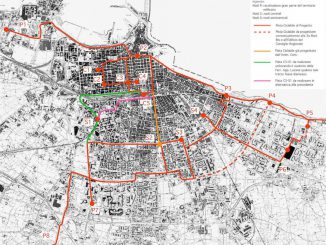
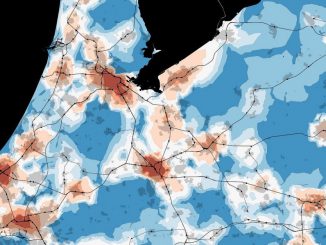
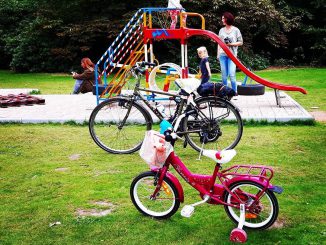
You must be logged in to post a comment.